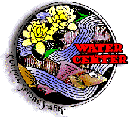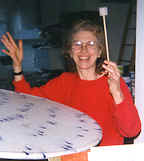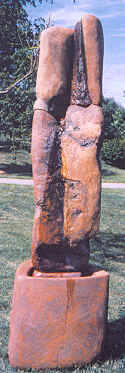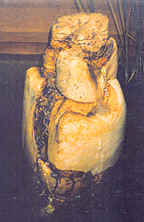
National Water Center, Eureka Springs, Arkansas

National Water Center, Eureka Springs, AR
Updated: April 2014 Contact: Contact: NWC
Contents ©1999-2014 by National Water Center. All rights reserved worldwide.
Present Moment, Wonderful Moment
Thich Nhat Hanh
Papermaking as a Vast Reservoir
Coco Gordon
Wolfgang Vaatz: Sculpting with Clay and Water
Kerstin Wiederhold
water soul
Rosemary Zieroth
Water and the Human Spirit
Patricia D. Michael & Gayle Borst
Livin Water, Urban Vitality
Betsey Damen
Water Divine
Susan Dean
Chop Wood, Carry Water
Anonomous
Present Moment, Wonderful Moment*
by Thich Nhat Hanh
6. Turning on the Water
Water flows from high in the mountains.
Water runs deep in the Earth.
Miraculously, water comes to us,
and sustains all life.
Even if we know the source of our water, we still take its appearance for granted. But it is thanks to water that life is possible. Our bodies are more than seventy percent water. Our food can be grown and raised because of water. Water is a good friend, a bodhisattva, which nourishes the many thousands of species on Earth. Its benefits are numberless.
Reciting this gatha before turning on the faucet or drinking a glass of water enables us to see the stream of fresh water in our own hearts so that we feel completely refreshed. To celebrate the gift of water is to cultivate awareness and help sustain our live and the lives of others.
7. Washing Your Hands
Water flows over these hands.
May I use them skillfully
to preserve our precious planet.
Our beautiful Earth is endangered. We are about to exhaust her resources by polluting her rivers, lakes, and oceans, thus destroying the habitats of man species, including our own. We are destroying the forests, the ozone layer, and the air. Because of our ignorance, fears, and hatred of one another, our planet may be destroyed as an environment hospitable to human life.
The Earth stores water, and water gives life. Observe your hands as the water runs over them. Do you have enough clear insight to preserve and protect this beautiful planet, our Mother Earth?
40. WATERING THE GARDEN
Water and sun
green these plants.
When the rain of compassion falls,
even a desert becomes an immense, green ocean.
Water is the balm, or nurturance, of compassion which has the capacity to restore us to life. The Bodhisattva of Compassion is often depicted holding a vase of water in her left hand, and a willow branch in her right. She sprinkles down compassion, like drops of nurturing balm, to revitalize tired hearts and minds weak from suffering. Rain enlivens crops and protects people from hunger. Watering the garden, the compassionate rain falls on the plants. Our respect and gratitude for this gift of water helps us heal ourselves and transform even a desert into an immense, green ocean.
When we offer water to plants, we offer it to the whole Earth. When watering plants, if we speak to them, we are also speaking to ourselves. We exist in relationship to all other phenomena. As we water plants, we can speak to them:
Dear plant, you are not alone.
This stream of water comes from Earth and sky.
We are together for innumerable lifetimes.
Page 38
Papermaking as a Vast Reservoir
by Coco Gordon

The eco-philosophical female-driven work I’ve come to in my visual art, writing and bookmaking was entered via papermaking—with its vast teachings of biodiversity origins, seed, its respect for life-death-seasonal rebirth cycles, by teaching timing, manner of growth and harvesting, and with its opportunities to learn to communicate with the many indigenous, eastern and western culture: their needs, their practices, their wisdom, their failings.
I now often use plants without using them, for their story, four understanding our story. I now reuse clothing not only for making paper but recycled as canvas for paper paintings poured on my vacuum table, which become magic veils and ecological indictments. As a bioregionalist I wish to respect the principles of local sustainable action, of non-violence to our life systems, of nature’s biomass restoring itself, and the self-propagation, self-regulation, self-education, self-fulfillment put in place when all species are allowed to interrelate.
From 1975, catapulted into all possible ways to make paper, I did works installed by different curators from my given parts into cascading water like sculptures that kept the imprint of water being poured. I made paper clothes to wear like skin. I explored the experience of pulp as art when wet, Paper Pools. Making a paper drum on a circle of copper introduced the equal weight of sound — a tympani resonance that tuned with change of the air’s moisture. I installed No More Water — seeds and the pulp-dribbled word water shriveled up in their parched wave of earth. At a Shasta Bioregional Gathering grassroots people renamed themselves bunchgrass people. I was one of them. Wildness reclaimed. I organized Artists Perform From Their Ecological Source: Working to Re-Open Major Life Systems for a weeklong Med-Art Conference. I composted Unframed Intelligence with red worms in a neighborhood store window for three months, transforming food scraps and handmade paper flag into a statement on the Gulf War. I called my art an inquiry into human-earth health — a forest-work Displacement View in Banff, Canada. Radical Food in Vienna, the revisiting of SuperSkyWoman at my birthplace, Genova, Italy. On an east facing lookout on Maui, rain pools of reddest earth pulled my back-walking mud-rubbed hands and feet into timeless time for a video The Future of Hands and Feet.
Presently I am researching how to tie the papermaking process into the timeless time cycles of other life needs — wild areas, forage zones, reconstructing naturally filtering marshes, filtering of gray water systems, post-harvest die-back, bioremediation, and absorption by plants of toxic wastes. I’m thinking of how to make papermaking a sustainable integrated community industry rather than a cottage or mill industry.
With my newly attained Permaculture Apprentice certification I inaugurate a new art movement, TIKYSK, Things I Know You Should Know, which accesses the still operable available memory and skills needed to be a primal human co-operating with the primal earth community. As SuperSkyWoman I hover outside modern western culture, to track the affect of our progress.
Page 39
Wolfgang Vaatz: Sculpting with Clay and Water
by Kerstin Wiederhold (written after conversation with the artist)
 Since his childhood, Wolfgang was always drawn to mud, water, and aquatic life. Building his first pond when thirteen, he “started” his artistic career painting landscapes, and went as a young adult back to Namibia, his country of birth. In the Namibian desert, he studied the marks that wind and water action had made on the surface. Ever since then, he has been intrigued by art, created by processes in nature, such as a water flow, offering him inspirations for his experimental work.
Since his childhood, Wolfgang was always drawn to mud, water, and aquatic life. Building his first pond when thirteen, he “started” his artistic career painting landscapes, and went as a young adult back to Namibia, his country of birth. In the Namibian desert, he studied the marks that wind and water action had made on the surface. Ever since then, he has been intrigued by art, created by processes in nature, such as a water flow, offering him inspirations for his experimental work.
Sculpting with a compliant material, he manipulates clay so that the sculpture’s focus will be on the water. Directing the water movement in a rather complex and variant way, instead of straight channeling or jet-like shooting, Wolfgang allows the sculpture to become a place where art and nature interact. Although flowing water as an element of nature is “ dislocated,” it yet feels natural in visual, acoustical, and tactile regard, if displayed in this kind of art environment.
The fascination of water for humans is age old: water is the beginning and catalyst of life — of any form of life on earth. Therefore, water is a precious resource, even if one does not live in an arid environment. Yet, urbanization, industrialization, over-fertilization of farm land have done harm to the water.
Today, water is more often polluted then clean and clear. A pond water–sculpture, representing an environmental installation where the water plays the role of the performing artist, offers a lab situation. The interplay of water, sculpture, and pond-life constitutes a system that reflects in a much smaller scale our global system. The viewer, participating in the installation, will notice the system’s tangible balance, its cyclical nature, and its meaningful beauty. For example, in spring time, there will be an algae bloom in an outdoor pond. After an explosion of growth, most algae will die until a normal level is reached. Algae do not have to be fought with chemicals.
Wolfgang’s work is a form of non-verbal communication, addressing people regardless of their age, educational, or cultural background. The aesthetic and performance of each water-sculpture express a deep appreciation of nature. Both, visual shape and sound have to enhance each other and are “tuned” by the artist as if they were "tuned" by the erosional forces of nature over time. The result is a richness in experience that might challenge the viewer to open up his or her attitude toward an increased sensitivity for nature." In this sense, his work can remind us that we are all linked together: humans, art, and nature.o Contents
Page 40
water soul
by Rosemary Zieroth
 water
water
calm
water
gentle water
thundering
powerful
spiritual
water
like a human soul
flowing, moving, changing
eternal
under the
thundering, powerful
waterfall
the energy integrates with my soul
carries all but the good away
and my spirit is clean
Page 41
Water and the Human Spirit
by Patricia DuBose Michael & Gayle Borst
Water is Life...in much more than the physiological sense. It not only makes life possible, but it provides opportunities for enhancement of life through the healing power of living water, its restorative enveloping contact with the body, and the mere sight and sound of it.
Water is practical, mystical and magical. It delights us in many forms: a sparkling liquid lake at sunset, softly falling crystalline snowflakes, a roaring foamy waterfall, the diamond-like glistening glaze in the sunshine after a Central Texas ice storm, or a gurgling dynamic rock smoothing stream.
We did a presentation in September 1996 designed to be a rich sensory reminder of the many and varied ways that water touches the human spirit and enriches our lives. We looked at aspects such as the healing power of water; the effect of the sight, sound and smell of water on human emotion; personal space and water; water and the sacred / mystical / religious; water in the built environment; and more. We served up a lavish feast of water images, sounds, facts and lore.
Patricia is an experienced social and environmental activist, designer, lecturer and educator who has produced multiple educational events in the U.S., Europe, Canada, Mexico and Central America.
Gayle has been exploring the human attraction to water and how to bring it into the built environment in ways that evoke feelings similar to those produced in the natural environment. As a biologist and practicing architect, she is seeking ways to restore the connection between the natural world and the human built environment.
Living Water, Urban Vitality:
The Art and Science of City Water Quality
by Betsy Damon
Environmental artist, urban designer and founder, Keepers of the Waters
Betsy Damon is the founder of Keepers of the Waters, a not-for-profit foundation committed to involving artists, scientists, and citizens in projects that improve water sources and educate about the importance of water quality.
Her most recent success is a 5.9 acre "Living Water Garden" on the banks of the Fu-Nan rivers in the city of Chengdu, China. Designed to resemble the shape of a fish, the unique park draws water from the polluted river, naturally directs it through a series of flow forms and constructed wetlands, and releases the cleaned water back into the river. The park also includes 100 species of trees and plants selected by a local botanist, a living water fountain, sculptures that mimic the movement of mountain streams, and a 400-seat amphitheater for lectures and performances.
The realization of the project is even more impressive than its design. Faced with great resistance from engineers and government officials who preferred traditional flood walls and dams, Damon nurtured relationships and persuaded the city government to help build the park. Now complete, the project has been visited by mayors of ten major Chinese cities and has been declared a national model by the government in Beijing.
Page 42
Water Divine
by Susan Dean
Susan writes about her daily living and nightly dreaming from an "unplugged" Adirondack cabin self-built with James Dean, her husband of over twenty years. She completed her first book length manuscript, A Violet Tapestry.
At long last, after five years of hard labor, financial sacrifice, and the exclusion of a social life, the rustic cabin in the Adirondack Mountains where my husband and I would be making our permanent home was almost ready for occupancy. We had done things backwards in one respect — we had left the issue of water to deal with last. Ordinarily, it is a good idea to have your well dug before or during construction, but we didn’t get around to it until just before we moved in. In the back of our minds, we had always felt assured that there must be water on the property because of the abundance of streams and springs throughout the area.
I had tried some amateur dowsing myself and had a feeling about a couple of spots, which later turned out to be where we located the well. However, we called in a professional — known local dowser Ted Kaufman, who has made dowsing his life’s avocation. In addition to finding water, he has located many people who have been lost up in these mountains and lakes, by dowsing with plumb bob over a map. Not only was it very interesting to watch him work, but he got the whole family involved in the process, giving the children coat hangers to test their own natural ability. Ted was able to tell us various things about the vein of water: the location, direction of flow, depth, gallons per minute. We followed his advice, which proved to be right on target.
Strangely, (or not) I had had a dream about a very powerful source of water up behind the house, and I wanted to test it out on Ted. In the dream I had found myself standing on a place we referred to as “Sean’s Spot” because our sensitive little son especially liked to hang around there. I could feel the ground actually rumbling under the rock I was standing on, so powerful was the flow of water beneath my feet. Ted and his divining rod tuned into the reality of the dream immediately. He informed me that a “dome” was located there. I was unfamiliar with the term, so he explained that it was a major “column” of water coming from deep within the earth, with smaller underground streams radiating out from it, one of which was the vein we tapped our well into. Through further reading, I later discovered that many ancient sacred sites were originally built over springs like this one. In fact, they are the present-day sites of many cathedrals because in the Christians’ attempts to obliterate pagan places of worship they actually pre-empted these potent energy centers. So, you could say that we were attracted by strong natural forces to our own personal sacred site. We have gone on to find more locations around here which would qualify, in my mind, as sacred.
There is another nearby source of water where we prefer to get our drinking water. It is a turn-of-century dug well, about twenty feet deep, expertly lined with cobblestones, constructed in anticipation of a potentials settlement when this area was being considered as a garnet mine site. Before I knew this, I used to wonder why I sometimes dreamed of phantom houses and dirt roads beyond us where there is actually nothing except what-might-have-been.
While walking to the well, you are likely to see a raven or two flying over from Whortlberry Mountain. On one memorable trip, I answer a male’s raucous mating call, quite a throaty squawk. He flew right over my head, wings whipping audibly, then continued on his way, no doubt disappointed that I didn’t have shiny black tail feathers.
Once the matter of the water supply for our house was settled, our dream of living up on our own Adirondack mountain finally became a reality.
Page 43
Chop Wood, Carry Water
Sorry, this article has been removed.
Go To: h 2 oh! the more you know

Scroll down to see individual titles in this section.